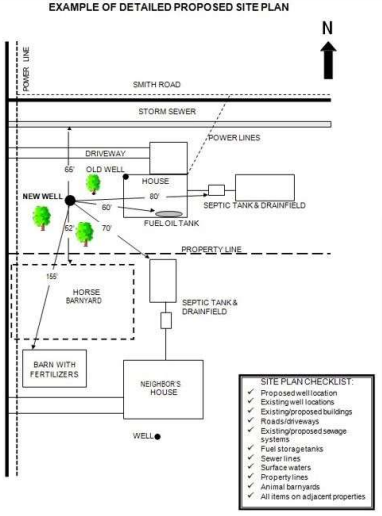One of the most important things to do before commencing construction on a private well is to select the well location. All the states in the U.S. have laid out detailed guidelines on where to construct a well on your property.
In this article, we will discuss the water well location map in the following 13 major states.
- Texas
- Colorado
- New Mexico
- Utah
- California
- Michigan
- Idaho
- Florida
- Washington State
- Virginia
- Georgia
- Wisconsin
- Massachusetts
Water Well Location Map According to States
It is important to highlight that all the 13 states mentioned above have outlined guidelines for locating a water well. These laws and directions are almost the same in all the states. The purpose of laying out these directions is to minimize contamination from other structures on your property like a septic system, chemical storage, animal waste storage, and other sources.
You also need to avoid fetching too much underground water from neighbors’ properties and avoiding contamination from an old well. It is a complicated process, and it is best if you hire a certified well driller to make this plan for you, even if your state allows drilling well on your property.
Here is a quick guide to help you move into a house with well water for the first time.
Minimum Distance from Contamination Sources
Let’s check out the minimum required distances.
| Contamination Source | Minimum Distance from Water Well (Feet) |
| Agricultural chemical or fertilizer storage or preparation area | 150 |
| Animal waste lagoon or manure storage | 150 |
| Animal or poultry yard | 50 |
| Brine wells or injection well | 150 |
| Building or projection thereof | 3 |
| Cemetery and graves | 50 |
| Cesspool | 50 |
| Chemical Storage | 150 |
| Contaminant plumes | 300 |
| Drain field | 50 |
| Dry well | 50 |
| Footing drain | 10 |
Fuel/chemical storage tanks – Underground or above grade and associated piping |
|
| depot/tank farm | 300 |
| 1,100 gal. or larger, without secondary containment | 300 |
| 1,100 gal. or larger with secondary containment | 50 |
| less than 1,100 gal | 50 |
| located in a basement, regardless of size | 50 |
| Grease trap | 50 |
| Kennel | 50 |
| Landfill or dump sites (Active or Inactive) | 800 |
| Liquid waste draining into the soil | 50 |
| Metering station for pipeline | 300 |
| Municipal wastewater effluent or sludge disposal area (land surface application or subsurface injection) | 300 |
| Municipal wastewater lagoon | 300 |
| Oil or gas well | 300 |
| Other wastewater handling or disposal unit | 50 |
| Petroleum product processing or bulk storage | 300 |
| Pipeline for gas, oil | 50 |
| Privy/outhouse | 50 |
| Seepage pit | 50 |
| Septic Tank | 50 |
| Septage waste (land application area) | 800 |
| Sewage holding tank | 50 |
| Sewage lagoon serving a single family dwelling | 50 |
| Sewage lagoon effluent – land application area | 50 |
| Sewage or liquid waste draining into soil | 50 |
| Sewage pump chamber, transfer station, or lift station | 50 |
| Sewers | 10-50 feet |
| Sump pit | 10-50 feet |
| Surface water (lake, river, stream, pond, ditch, etc.) | 10 |
| Unfilled space below ground surface (except an approved basement, basement offset, or crawl space beneath single family dwelling) | 10 |
There might be some variations in these distances from one state to another. Hence, it is best to consult the relevant department in your area before you submit a well permit.
Water Well Location Map
A specimen of water well location map is shown below.

Deviations
Local health and water authorities can issue deviations in special cases upon request. The deviation must be requested in writing prior to well construction. You will need to submit the following documents for a deviation approval.
- Why the rule cannot be met
- Water well location
- Distance to the source of contamination
- Detailed site plan
- Geologic conditions
- Neighboring well details
- Proposed well construction plan
Final Words
It is in your best interest to consult with the local authorities and certified well drillers before submitting a permit for approval. Local authorities hold the right to bar you from using well water and impose penalties if you are found violating the rules.
